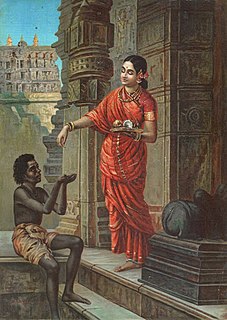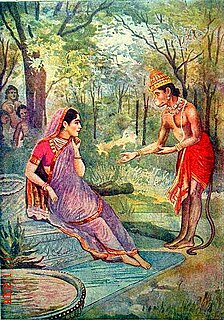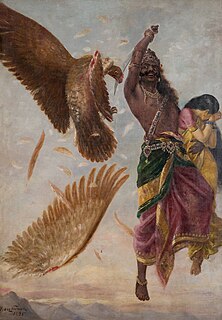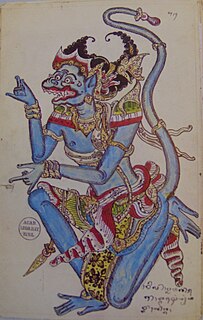
Rāmāyana is one of the two major Sanskrit epics of ancient India and important text of Hinduism, the other being the Mahābhārata.

Hanuman is a Hindu god and divine vanara companion of the god Rama. Hanuman is one of the central characters of the Hindu epic Ramayana. He is an ardent devotee of Rama and one of the chiranjivis. Hanuman is also son of the wind-god Vayu, who in several stories played a direct role in Hanuman's birth. Hanuman is mentioned in several other texts, such as the epic Mahabharata and the various Puranas.

In the Hindu epic Ramayana, Maricha, or Mareecha is a rakshasa (demon), who was killed by Rama, the hero of the epic and an avatar of God Vishnu. He is mentioned as an ally of Ravana, the antagonist of the epic. His most notable exploit is his role in the kidnapping of Sita, Rama's wife. His son Kalanemi was killed by Hanuman.

Vānara either refers to the monkeys or a race of forest dwelling people in the Hindu epic the Ramayana and its various versions. In the Ramayana, the Vanaras help Rama defeat Ravana. They are generally depicted as humnanoid apes or monkeys.

Reamker is a Cambodian epic poem, based on the Sanskrit's Ramayana epic. The name means "Glory of Rama".It is the national epic of Cambodia. The earliest mention of this epic's manuscript in Cambodia dated back in 7th century based on Veal Kantel inscription (K.359). While, the surviving text of Reamker dates from 16th century. Reamker adapts the Hindu ideas to Buddhist themes and shows the balance of good and evil in the world. More than just a reordering of the epic tale, the Reamker is a mainstay of the royal ballet's repertoire. Like the Ramayana, it is a philosophical allegory, exploring the ideals of justice and fidelity as embodied by the protagonists, King Rama and Queen Sita. The epic is well known among the Khmer people for its portrayal in Khmer dance theatre, called the L'khaon, in various festivals across Cambodia. Scenes from the Reamker are painted on the walls of the Royal Palace in Khmer style, and its predecessor is carved into the walls of the Angkor Wat and Banteay Srei temples. It is considered an integral part of Cambodian culture.

Ramcharitmanas, is an epic poem in Awadhi language, composed by the 16th-century Indian bhakti poet Tulsidas. The word Ramcharitmanas literally means "Lake of the deeds of Rama". It is considered one of the greatest works of Hindu literature. The work has variously been acclaimed as "the living sum of Indian culture", "the tallest tree in the magic garden of medieval Indian poetry", "the greatest book of all devotional literature" and "the best and most trustworthy guide to the popular living faith of the Indian people".

Mandodari was the queen consort of Ravana, the king of Lanka, according to the Hindu epic Ramayana. The Ramayana describes Mandodari as beautiful, pious, and righteous. She is extolled as one of the Panchakanya, the recital of whose names is believed to dispel sin.

Sita is a Hindu goddess and the heroine of the Hindu epic, Ramayana, and its other versions. She is described as the daughter of Bhūmi and the adopted daughter of King Janaka of Videha and his wife, Queen Sunayana. She has a younger sister, Urmila, and the female cousins Mandavi and Shrutakirti. Sita is known for her dedication, self-sacrifice, courage and purity.

Sundara Kaanda (IAST: Sundara Kāṇḍa, Sanskrit: सुन्दरकाण्ड {beautiful episode}, is the fifth book in the Hindu epic, the Ramayana. The original Sundara Kanda is in Sanskrit and was composed by Valmiki, who was the first to scripturally record the Ramayana. Sundara Kanda is the only chapter of the Ramayana in which the hero is not Rama, but rather Hanuman. The work depicts the adventures of Hanuman and his selflessness, strength, and devotion to Rama are emphasized in the text. Hanuman was fondly called “Sundara” by his mother Anjani and Sage Valmiki chose this name over others as the Sundara Kanda is about Hanuman's journey to Lanka.

Adhyatma Ramayana is a 13th- to 15th-century Sanskrit text that allegorically interprets the story of Hindu epic Ramayana in the Advaita Vedanta framework. It is embedded in the latter portion of Brahmānda Purana. The Hindu tradition attributes the text to the Bhakti movement saint Ramananda.
Adhyathmaramayanam Kilippattu is the most popular Malayalam version of the Sanskrit epic Ramayana. It is believed to have been written by Thunchaththu Ramanujan Ezhuthachan in the early 17th century, and is considered to be a classic of Malayalam literature and an important text in the history of Malayalam language. It is a retelling of the Sanskrit work Adhyatma Ramayana in kilippattu format. Ezhuthachan used the Grantha-based Malayalam script to write his Ramayana, although the Vatteluttu writing system was the traditional writing system of Kerala then. Recitation of Adhyathmaramayanam Kilippattu is very important in Hindu families in Kerala. The month of Karkitakam in the Malayalam calendar is celebrated as the Ramayana recitation month and Ramayana is recited in Hindu houses and temples across Kerala.

Hakgala Botanical Garden is one of the five botanical gardens in Sri Lanka. The other four are Peradeniya Botanical Garden, Henarathgoda Botanical Garden, Mirijjawila Botanical Garden and Seetawaka Botanical Garden. It is the second largest garden in Sri Lanka. The garden is contiguous to Hakgala Strict Nature Reserve.

Seetha Amman Temple is located approximately 1 kilometre (0.62 mi) from Hakgala Botanical Garden and 5 kilometres (3.1 mi) from Nuwara Eliya. The temple is located in the village of Seetha Eliya. This place is believed to be the site where Sita was held captive by Asur Samrat Ravana, and where she prayed daily for Rama to come and rescue her in the Hindu epic, Ramayana. On the rock face across the stream are circular depressions said to be the footprints of Lord Hanuman.

Hakgala is a mountain situated in the Nuwara Eliya district of Sri Lanka at 2,169 m (7,116 ft) above mean sea level, most parts of the mountain are covered with forest belonging to Hakgala Strict Nature Reserve. Hakgala Botanical Garden is situated on the northeastern slope of the Hakgala Mountain. The southwestern side of the mountain has a wet climate compared to northeastern slope since southwestern part faces directly to southwest Monsoon.

In some adaptations of the Hindu epic Ramayana, Maya Sita or Chaya Sita is the illusionary duplicate of the goddess Sita, who is abducted by the demon-king Ravana of Lanka instead of the real Sita.

Trijata is a rakshasi (demoness) in the Hindu epic Ramayana who is assigned the duty of guarding Sita who was kidnapped by the king of Lanka Ravana. In latter adaptions of Ramayana, Trijata is described as a daughter of Vibhishana, the brother of Ravana.

In the Ramayana, Sarama is the wife of Vibhishana, the brother of Ravana, the demon (rakshasa) king of Lanka. Sometimes, she is described a rakshasi (demoness), at other times, she is said to have gandharva lineage. All accounts agree that Sarama was friendly to Sita, the consort of Rama, who was kidnapped by Ravana and imprisoned in Lanka. Like her husband who sides with Rama in the war against Ravana, Sarama is kind to Sita and aids Rama. Sarama and Vibhishana had a daughter called Trijata.
In Hindu mythology, Jayanta, is the son of Indra, the king of the gods (devas) and his wife Shachi (Indrani). He resides in Svarga, the Hindu heaven, governed by Indra. He has a sister called Jayanti. He appears in various Hindu scriptures as fighting wars on behalf of the gods and his father. Jayanta also appears in the epic Ramayana and other lore, in which he disguises himself as a crow.

In the Hindu epic Ramayana, Nila, also spelled as Neela, is a vanara chieftain in the army of Rama, the prince of Ayodhya and avatar of the god Vishnu. He is the commander-in-chief of the monkey army under the monkey king Sugriva and is described as leading the army in Rama's battle against the rakshasa king Ravana of Lanka and as killing many rakshasas.




















